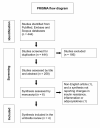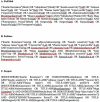Metabolic aspects of surgical subcutaneous fat removal: An umbrella review and implications for future research
- PMID: 36200436
- PMCID: PMC10113936
- DOI: 10.17305/bjbms.2022.8175
Metabolic aspects of surgical subcutaneous fat removal: An umbrella review and implications for future research
Abstract
Although obesity is a preventable disease, maintaining a normal body weight can be very challenging and difficult, which has led to a significant increase in the demand for surgical subcutaneous fat removal (SSFR) to improve physical appearance. The need for SSFR is further exacerbated because of the global rise in the number of bariatric surgeries, which is currently the single most durable intervention for mitigating obesity. Fat tissue is now recognized as a vital endocrine organ that produces several bioactive proteins. Thus, SSFR-mediated weight (fat) loss can potentially have significant metabolic effects; however, currently, there is no consensus on this issue. This review focuses on the metabolic sequelae after SSFR interventions for dealing with cosmetic body appearance. Data was extracted from existing systematic reviews and the diversity of possible metabolic changes after SSFR are reported along with gaps in the knowledge and future directions for research and practice. We conclude that there is a potential for metabolic sequelae after SSFR interventions and their clinical implications for the safety of the procedures as well as for our understanding of subcutaneous adipose tissue biology and insulin resistance are discussed.
Conflict of interest statement
Conflict of interest: The authors declare no conflicts of interest.
Figures



Similar articles
-
The impact of prior obesity surgery on glucose metabolism after body contouring surgery: A pilot study.Biomol Biomed. 2023 Sep 4;23(5):873-882. doi: 10.17305/bb.2023.8827. Biomol Biomed. 2023. PMID: 37021835 Free PMC article.
-
The 2020 ESPEN Arvid Wretlind lecture: Metabolic response in bariatric surgery - Mechanisms and clinical implications.Clin Nutr. 2021 May;40(5):2602-2608. doi: 10.1016/j.clnu.2021.03.044. Epub 2021 Apr 20. Clin Nutr. 2021. PMID: 33933726 Review.
-
Does bariatric surgery improve adipose tissue function?Obes Rev. 2016 Sep;17(9):795-809. doi: 10.1111/obr.12429. Epub 2016 Jun 8. Obes Rev. 2016. PMID: 27272117 Free PMC article. Review.
-
Bioelectrical Impedance Analysis Detects Body Fat Changes After Surgical Subcutaneous Fat Removal.Metab Syndr Relat Disord. 2024 May;22(4):281-286. doi: 10.1089/met.2023.0223. Epub 2024 Mar 18. Metab Syndr Relat Disord. 2024. PMID: 38502809
-
The short-term and long-term effects of bariatric/metabolic surgery on subcutaneous adipose tissue inflammation in humans.Metabolism. 2017 May;70:12-22. doi: 10.1016/j.metabol.2017.01.030. Epub 2017 Feb 2. Metabolism. 2017. PMID: 28403936 Free PMC article.
Cited by
-
Previous Body-Contouring Surgery Before Metabolic and Bariatric Surgery: Does It Matter?Obes Surg. 2023 Dec;33(12):4168-4169. doi: 10.1007/s11695-023-06873-z. Epub 2023 Oct 13. Obes Surg. 2023. PMID: 37833488 No abstract available.
-
The impact of prior obesity surgery on glucose metabolism after body contouring surgery: A pilot study.Biomol Biomed. 2023 Sep 4;23(5):873-882. doi: 10.17305/bb.2023.8827. Biomol Biomed. 2023. PMID: 37021835 Free PMC article.
-
Enhancing Safety in Tumescent Liposuction: Managing Sedation-Related Respiratory Issues and Serious Complications Under Deep Sedation with the Propofol-Ketamine Protocol.Aesthetic Plast Surg. 2024 May;48(10):1964-1976. doi: 10.1007/s00266-024-03963-w. Epub 2024 Mar 27. Aesthetic Plast Surg. 2024. PMID: 38536431
References
-
- Obesity and overweight [Internet]. [cited 2021 Mar 14]. Available from: https://www.who.int/news-room/fact-sheets/detail/obesity-and-overweight.
-
- Cao H. Adipocytokines in obesity and metabolic disease. J Endocrinol. 2014 Feb 1;220(2):T47–59. https://doi.org/10.1530/JOE-13-0339. - PMC - PubMed
-
- Bergé J-P, Barnathan G. Fatty acids from lipids of marine organisms: molecular biodiversity, roles as biomarkers, biologically active compounds, and economical aspects. Adv Biochem Eng Biotechnol. 2005 Aug 24;96:49–125. https://doi.org/10.1007/b135782. - PubMed
-
- Achari AE, Jain SK. Adiponectin, a therapeutic target for obesity, diabetes, and endothelial dysfunction. Int J Mol Sci. 2017 Jun 21;18(6):1321. https://doi.org/10.3390/ijms18061321. - PMC - PubMed
-
- Frayn KN. Adipose tissue and the insulin resistance syndrome. Proc Nutr Soc. 2001 Aug;60(3):375–80. https://doi.org/10.1079/pns200195. - PubMed

